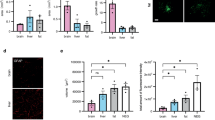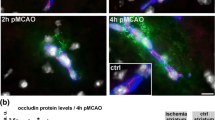Summary
It is still unknown when and in which area endothelial regeneration occurs after brain injury, and to what extent such changes depend on the severity of the injury. We have, therefore, studied bromodeoxyuridine (BrdU) uptake by regenerating endothelial cells in two different groups of rats given cold lesions using immunohistochemistry employing anti-BrdU monoclonal antibody, anti-factor VIII-related antigen antibody and anti-glial fibrillary acidic protein antibody. The earliest evidence for the presence of BrdU-positive endothelial cells (BrdU+end) was observed at 2 days after injury, the injured endothelial cells regenerating from the edge toward the center of the lesion in both groups. We considered that edema fluid could act as an important factor, since at 2 days post-injury BrdU+end were not in contact with macrophages and were always found in Evans blue-stained areas. Study of endothelial cell kinetics also confirmed that the repair of injured endothelial cells was intimately involved in the reconstruction of the blood-brain barrier, since the time of disappearance of BrdU+end coincided with the disappearance of Evans blue-stained areas. The difference in the process of endothelial regeneration was first apparent on the 3rd day, there being no difference at 2 days.
Similar content being viewed by others
References
Beck DW, Hart MN, Cancilla PA (1983) The role of macrophage in microvascular regeneration following brain injury. J Neuropathol Exp Neurol 42:601–614
Brightman MW, Klazo I, Olsson Y, Reese TS (1970) The blood-brain barrier to proteins under normal and pathological conditions. J Neurol Sci 10:215–239
Cancilla PA, DeBault LE (1980) Freeze injury and repair of cerebral microvessels. Adv Exp Med Biol 131:257–269
Cancilla PA, Formmes BS, Kahn LE, Debault LE (1979) Regeneration of cerebral microvessels. A morphologic and histochemistry study after local freeze-injury. Lab Invest 40:74–82
Fratkin JD, Cancilla PA, DeBault LE (1980) Platelet factor and cerebrovascular endothelium. Platelet-induced mitogenesis. Thromb Res 19:473–483
Gospodarowicz D, Brown KD, Birdwell CR, Zetter BR (1978) Control of proliferation of human vascular endothelial cells. J Cell Biol 77:774–778
Gratzner HG (1982) Monoclonal antibody to 5-bromo- and 5-iododeoxyuridine. A new reagent for detection of DNA replication. Science 218:474–475
Hirano A, Becker NH, Zimmerman HM (1970) The use peroxidase as a tracer in studies of alterations in the blood-brain barrier. J Neurol Sci 10:205–213
Hoshino T, Nagashima T, Murovic JA, Wilson CB, Edward MSB, Gutin PH, Davis RL, Dearmond SJ (1986) In situ cell kinetics studies on human neuroectodermal tumors with bromodeoxyuridine labeling. J Neurosurg 64:453–459
Ikuta F, Yoshida Y, Ohama K, Oyanagi S, Takeda S, Yamazaki K, Watabe K (1983) Revised pathophysiology on BBB damage. Acta Neuropathol (Berl) [Suppl] VIII:103–110
Klatzo I (1967) Neuropathological aspects of brain edema. J Neuropathol Exp Neurol 26:1–14
Maciag T, Cerundole J, Ilsley S, Kelly PR, Forand R (1979) An endothelial cell growth factor from bovine hypothalamus. Identification and partial characterization. Proc Natl Acad Sci USA 76:5674–5678
Mcauslan BR, Hannan GN, Reilly W, Stewart FHC (1980) Variant endothelial cells. Fibronectin as a transducer of signals of migration and neovascularization. J Cell Physiol 104:177–186
Orita T, Nishizaki T, Kamiryo T, Harada K, Aoki H (1988) Cerebral microvascular architecture following experimental cold injury. J Neurosurg 68:608–612
Tengvar Ch, Olsson Y (1982) Uptake of macromolecules into neurons from a focal vasogenic cerebral edema and subsequent axonal spread to other brain regions. Acta Neuropathol (Berl) 57:233–235
Vorbrodt AW, Lossinsky AS, Wisniewski HM, Suzuki R, Yamaguchi T, Masaoka H (1985) Ultrastructural observations on the transvascular route of protein removal in vasogenic edema. Acta Neuropathol (Berl) 66:265–273
Yoshimine T, Ushio Y, Hayakawa T, Takemoto O, Maruno M, Mogami H (1986) Growth activity of tumors at different intracranial structures. Immunohistochemical study with bromodeoxyuridine. Acta Neuropathol (Berl) 71:15–18
Author information
Authors and Affiliations
Rights and permissions
About this article
Cite this article
Orita, T., Akimura, T., Kamiryo, T. et al. Cerebral endothelial regeneration following experimental brain injury. Acta Neuropathol 77, 397–401 (1989). https://doi.org/10.1007/BF00687374
Received:
Revised:
Accepted:
Issue Date:
DOI: https://doi.org/10.1007/BF00687374




